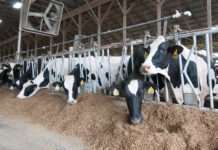The general target date for planting wheat for optimum grain yields in Kansas is within a week of the best pest management planting date, or BPMP (formerly known as the “Hessian fly-free”) date. If forage production is the primary goal, wheat should be planted in early to mid-September. But if grain yields are the primary goal, then waiting until the fly-free date to start planting is the best approach.
This doesn’t always work according to plan, of course. Some years, the earlier-planted wheat does best and some years the later-planted wheat does best, depending on weather conditions and disease pressure during the growing season. If fields become too wet to plant by mid-October and stay that way through the remainder of the fall, then producers end up planting much later than they’d like. This is an incentive to start planting earlier than the fly-free date if soil conditions are good.
But it’s a good idea not to go overboard and start planting too much earlier than the BPMP date (which can seem quite late to some, especially in south central Kansas). What’s wrong with planting a few weeks earlier than the BPMP date? There are several problems that can arise from planting too early:
- Increased risk of wheat streak mosaic and related diseases. Wheat curl mites survive over the summer on living plant tissue of volunteer wheat and certain other grasses. As soon as those host plants die off, the wheat curl mites leave and start searching for a new source of living plant tissue. Wheat that is planted early is likely to become infested, and thus become infected with wheat streak mosaic, high plains virus, and Triticum mosaic virus. The wheat curl mites can normally move only about a half mile through the air before dying, so if wheat is planted early, make sure all volunteer wheat within a half-mile is completely dead at least two weeks before planting.
- Increased risk of Hessian fly. Over the summer, Hessian fly pupae live in the old crowns of wheat residue. After the first good soaking rain in late summer or early fall, these pupae (or “flaxseed”) will hatch out as adult Hessian flies and start looking for live wheat plants to lay eggs on. They are most likely to find either volunteer wheat or early-planted wheat at that time. After the BPMP date, many of the adult Hessian fly in a given area will have laid their eggs, so there is generally less risk of Hessian fly infestation for wheat planted after that date. But Hessian fly adult activity has been noted through November or even early December in Kansas.
- Increased risk of barley yellow dwarf. The vectors of barley yellow dwarf are greenbugs and bird cherry-oat aphids. These insects are more likely to infest wheat during warm weather early in the fall than during cooler weather.
- Increased risk of excessive fall growth and excessive fall tillering. For optimum grain yields and winter survival, the goal is for wheat plants to head into winter with established crown roots and 2-4 tillers. Wheat that is planted early can grow much more than this, especially if moisture and nitrogen levels are good. If wheat gets too big in the fall, it can use up too much soil moisture in unproductive vegetative growth and become more susceptible to drought stress in the spring if conditions are dry.
- Increased risk of take-all, dryland foot rot, and common root rot. Take-all is usually worse on early-planted wheat than on later-planted wheat. In addition, one of the ways to avoid dryland foot rot (Fusarium graminearum, and other Fusarium species) is to avoid early seeding. This practice promotes large plants that more often become water stressed in the fall, predisposing them to invasion by the fungi. Early planting of wheat also favors common root rot because this gives the root rot fungi more time to invade and colonize root and crown tissue.
- More expensive to control grassy weed infestations. If cheat grass, downy brome, Japanese brome, or annual rye comes up before the wheat is planted, it can be controlled with glyphosate or tillage. If wheat is planted early and these grassy weeds come up after the wheat has emerged, producers will have to use an appropriate grass herbicide to control them.
- Germination problems due to high soil temperatures. Early planted wheat is sown in hotter soils, which may cause problems as some wheat varieties have high-temperature germination sensitivity (in other words, some varieties won’t germinate when soil temperatures are greater than 85°F). If planting early, it is important to select varieties that do not have high-temperature germination sensitivity. Sensitive varieties should be sown later in the fall, when soil temperatures have cooled down.
- Germination problems due to shortened coleoptile length. Hotter soils tend to decrease the coleoptile length of the germinating wheat. Therefore, deeply planted wheat may not have a long-enough coleoptile to break through the soil surface and may result in decreased emergence and poor stand establishment. If soil moisture is absent from the top inch of the soil profile at planting time, it is preferable to dust the wheat in at a shallower depth (3/4 to 1 inch deep) when early planting wheat than trying to reach moisture in deeper layers if soil moisture is absent from the top inch of the soil profile. This is because of the shortened coleoptile length in hotter soils.



